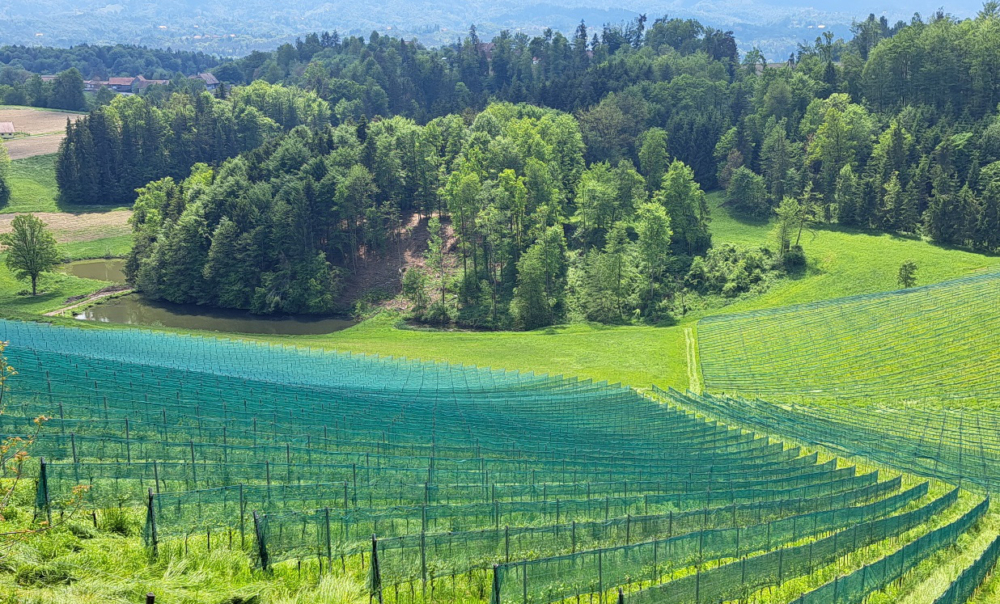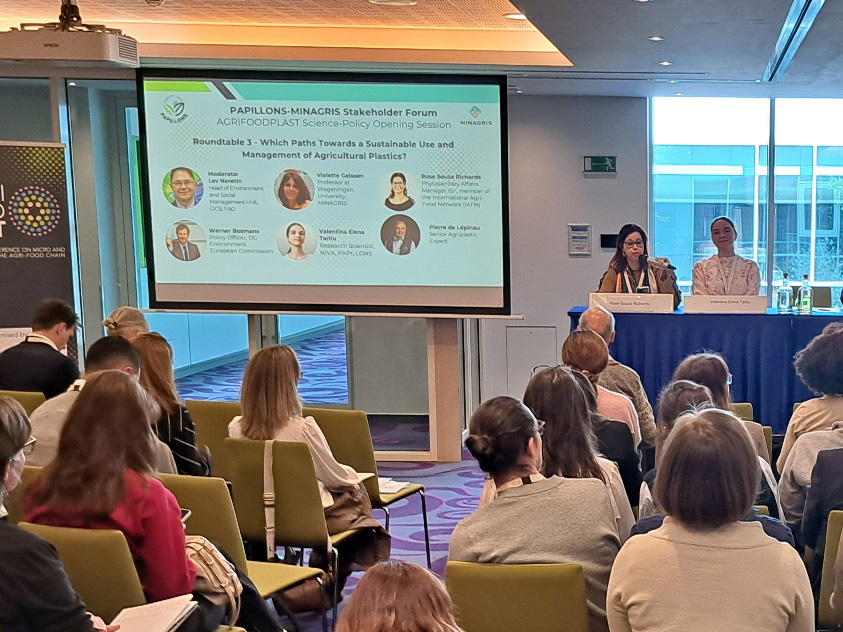Newsletter No. 9
Newsletter No. 9 brings you the latest updates from NETmicroplastic, including highlights from our recent webinar on the use of plastics in viticulture and key takeaways from the AGRIFOODPLAST Conference in Brussels. The conference focused on the occurrence and behavior of plastic pollution, its ecotoxicological impacts, and innovative approaches to designing agriplastics with sustainability in mind.
This edition also features news on newly funded EU projects dedicated to developing biodegradable bioplastics for agricultural use and exploring the effects of microplastics on soil health.
Looking ahead, we’re excited to invite you to our upcoming web dialogue on biodegradable materials in agriculture, taking place in two weeks, and to share a save-the-date for the NETmicroplastic conference meeting this November.
Webinar: Plastic use in viticulture
On 29 January 2025, NETmicroplastic hosted a webinar organised by Bündnis Mikroplastikfrei on the use of plastic tools in viticulture. The webinar brought together stakeholders from politics, education, administration, and research and development, as well as practitioners and stakeholders actively involved in viticulture and wine growing. The aim was to promote innovative technological solutions and support policy-making to reduce plastic pollution in vineyards.
Sophie Butz from the Umathum winery gave a comprehensive overview of commonly used products and tools and explained about their application in the vineyard. Franz Paschinger from the Urbanihof Winery pointed out several ways of avoiding plastic deposition and contamination on the field. For example, plastic binders should be collected after use, but this is very costly. Conventional growth sheets become brittle through weathering, leading to plastic contamination in the soil. On the other hand, biodegradable liners are often not durable enough, depending on the type of material used. Paper-based covers are also available but are less suitable in years with high rainfall. In particular, pheromone strips made from biodegradable materials have been used successfully. Mr. Paschinger sees a strong commitment among winemakers to increasingly address the overall issue of microplastic avoidance. From the winemakers’ perspective, there is a need to make biodegradable products more widely available to users to replace conventional plastic products. The involvement of suppliers of relevant equipment and tools is key, as is raising awareness about the use of plastics in the sector. The dialogue clearly showed that certain plastic products commonly used in viticulture are, indeed, problematic, such as plant protection covers, plastic tapes used as binders, and threads for mowing machines. The use of these items inevitably results in plastic shedding and deposition on the field.
To achieve a ‘plastic-free’ vineyard, substitutes that are biodegradable in the soil need to be made more widely available. At present, growers are experimenting with different products, due to a lack of information and knowledge about alternative products and their properties. As a result, NETmicroplastic is preparing a leaflet that will list relevant biodegradable products together with information on user experiences. Publication of the leaflet is planned for autumn 2025.
Recent research projects tackling microplastics in agriculture
Recent research projects tackling microplastics in agriculture
Here we highlight some newly funded EU projects, starting between September 2024 and March 2025, that aim to develop biodegradable bioplastic materials for agricultural applications or study the impact of microplastics on the soil environment. These include two MSCA Postdoctoral Fellowships, TREX-MPs and BIOFARM, the ERC grant NanoSoil, two Innovation Actions, Landfeed and SurfToGreen, and two RIAs PHAantastic and MAGICBIOMAT. All project details can be found in our NETmicroplastic database.
LANDFEED Theory-Driven Engineering of Photocatalysts for Microplastics Degradation
Start date 09/2024
LANDFEED will focus on creating value from under-utilised wastes from the agro-food industry, forestry, urban and natural wastes, implementing circular and local solutions that allow waste to be valorised by placing it in a circular framework, and producing innovative biofertilisers to improve Europe’s self-sufficiency. In addition to optimising and implementing innovative nutrient recovery technologies, work will be carried out on a new generation of coatings for these bio-based fertilisers, capable of improving their efficiency through controlled nutrient release mechanisms.
PHAntastic PHA-based iNnovative agriculTurAl Solutions to deliver bio-based ferTIlisers and plant protection produCts
Start date 09/2024
PHAntastic will develop two families of delivery systems (mulch films and growth foams) based on PHAs containing active bioproducts (amino acids & hydrolyzed proteins, microelements, elicitors and plant growth promoting rhizobacteria -PGPR) instead of synthetic agrochemicals. Products will be demonstrated with end users on horticultural crops and trees in Northern and Southern Europe.
BIOFARM Biobased, fully biodegradable, microplastic-free nanocarriers selectively releasing encapsulated actives for sustainable agriculture
Start date 09/2024
BIOFARM will develop a general approach to encapsulate crop protection products in engineered nanocarriers for foliar spraying. Without adding environmentally problematic additives, the enhanced adhesion of the proposed nanocarriers will be tailored through bio-polymer modification and green formulation design.
TREX-MPs Theory-Driven Engineering of Photocatalysts for Microplastics Degradation
Start date 10/2024
TREX-MPs combines theoretical and experimental approaches, focusing on the degradation of polystyrene MPs using TiO2 and CeO2 to reduce MPs in wastewater on a larger, environmentally friendly scale.
SurfToGreen Bio-based sustainable SURFactants TO foster GREEN industry
Start date 10/2024
The EU-funded SurfToGreen project aims to develop a new surfactant platform to replace current benchmarks across various industrial applications. SurfToGreen will use biomass-derived building blocks to create novel bio-based surfactants, encompassing anionic, nonionic, cationic, and zwitterionic surfactant families, as well as biopolymers and oligomers sourced from renewable materials.
MAGICBIOMAT Manufacturing guiding tool for circular and programmed biodegradable materials under open environment conditions
Start date 01/2025
MAGICBIOMAT aims to develop a portfolio of circular bio-based materials with programmed biodegradability by developing a trustworthy Artificial Intelligence (AI)-based software to guide material design and production, and then demonstrating it through two applications with highly concerning littering rates: mulching films and paper-based packaging, tested in open environment conditions (soil, fresh water and marine) and different EU climates.
NanoSoil Nano- and colloidal plastics in soil: input, plant uptake and risk assessment
Start date 03/2025
The NanoSoil project will investigate the detection of submicron plastics in soil using Field-Flow Fractionation (FFF). It will focus on agricultural practices such as compost and sludge application, wastewater irrigation and plastic mulching as the main pathways for sub-micron plastics entering the soil, as well as biodegradable films in agriculture. Additionally, the project will assess plant uptake of submicron plastics for representative crops under realistic conditions.
Conference Report
The AGRIFOODPLAST conference 2025, held in Brussels on 8-9 April, presented the latest findings on the environmental and human health risks associated with nano- and microplastics (MPs), plastic-related chemicals in food production and packaging, policy developments and implementation strategies and NETmicroplastic was there with a poster about its goals and achievements.
Several presentations, in particular from the EU-funded Minagris and Papillons projects, highlighted the urgent need for quality control and harmonisation in MP analysis. Results from field studies showed significant variability – MP measurements often varied by a factor of 100 between laboratories. These discrepancies can be attributed not only to sample preparation methods, but also to the analysis software used. Many laboratories tend to underestimate MP concentrations. Overall, laboratories using ISO standards showed more reliable results.
Plastics use and management practices were reported to vary widely across Europe. For example, greenhouse films dominate in Italy, while silage films are more common in Norway and France. A survey of European farmers conducted as part of the Minagris project showed that irrigation tubes are the most commonly used in tomato production and mulch film is the most commonly used in asparagus production. Farmers reported that without mulch, yields could decrease by more than 50%. Field trials in Spain, Germany and Finland have shown that the effect of MPs varies by region and is more pronounced at higher concentrations. This highlights the need for local validation of MP distribution maps, taking into account crop types and farming systems.
Several field studies have also investigated the use of biodegradable mulch films and found that degradation is minimal at low soil temperatures. In addition, these materials can disrupt the nitrogen cycle, leading to an imbalance in the C/N ratio. To accurately assess biodegradability, a three-step approach is recommended, using standard laboratory tests (e.g. respirometry) in combination with mesocosm studies (quantification of decomposition and erosion rates) and field trials.
Collaboration between all stakeholders – including researchers, policy makers, farmers and industry – is essential to make informed decisions. As emphasised during the Science Policy Forum on the first day: “Farmers are not waste managers; they need knowledge, capacity and funding”.
To support this, a set of indicators will be developed to assess both the efficacy and biodegradability of plastics in agriculture. These indicators will be integrated into a decision support tool currently under development to help farmers make more informed choices.
UPCOMING EVENTS
Webinar: Biodegradable Materials in Agriculture (in German)
29.04.2025 | 16:00 – 17:00 Uhr | Online, registration open
We are delighted to conclude our engaging web dialogue series with an insightful session on “Biodegradable Materials in Agriculture”. Following our previous sessions focusing on ‘Plastic Use in Agronomy’ and ‘Plastic Use in Viticulture’, this final session will take a deep dive into the concept of biodegradability. Join us to learn from leading experts from academia and industry about the current use and the potential of biodegradable materials in agriculture.
Don’t miss this opportunity to learn and get involved!
The full programme is available on: Webdialog: Biologisch abbaubare Materialien in der Anwendung – NETmicroplastic.
Free registration is possible under: Webdialog – Anmeldung
NETmicroplastic conference meeting and mini-fair
06.11.2025 | 9:00 am – 4:30 pm | Tulln/Austria registration open
On 6 November, the NETmicroplastic conference meeting and mini-fair will take place at the UFT in Tulln, Austria. The conference will include presentations from academia, industry and agricultural practice with a focus on practical experiences with plastic tools and materials, especially biodegradable ones and fertilizers as a source of microplastics. We invite our partners and associate members to present their products, services and research on a first-come, first-served basis.
The tentative conference programme is as follows:
9:00 Arrival & coffee
9:30-10:00 Microplastics in agricultural soil – sources, regulations, potential solutions
10:00-11:00 Impact of the use of plastics on agricultural soil in Europe – results from field studies
11:00-11:30 Coffee break
11:30-12:30 Fertilizers as a source of microplastics in soil
12:30-13:30 Lunch
13:30-14:30 Tour of the stakeholder exhibition
14:30-15:30 Panel discussion: Sharing ideas and best practice in the field and vineyard
15:30-16:30 Networking with local wine & snacks
Free registration is possible under Conference meeting 6 November 2025 – NETmicroplastic
If you are interested in presenting at a booth, please send an email to info@net-microplastic.eu.





